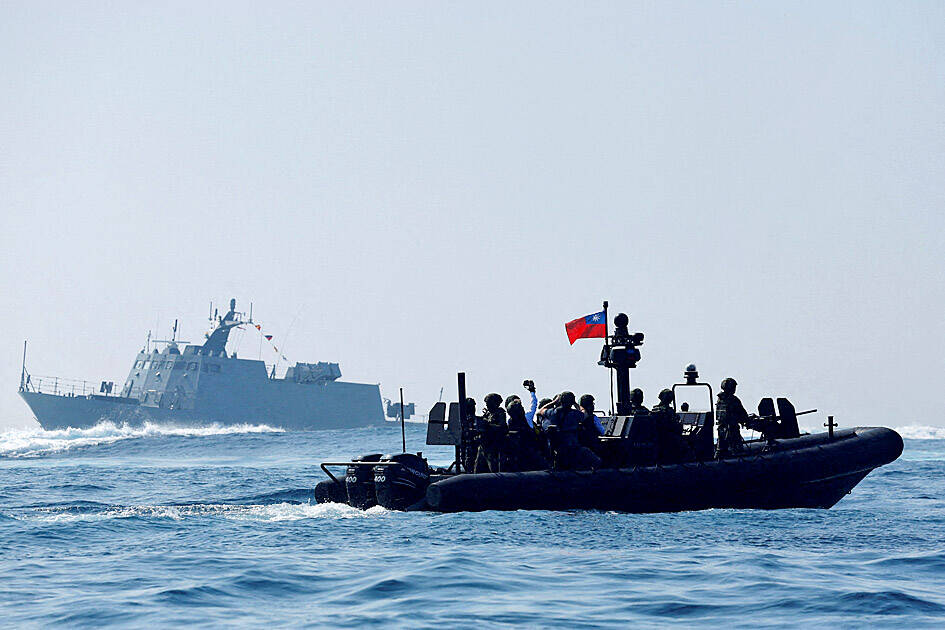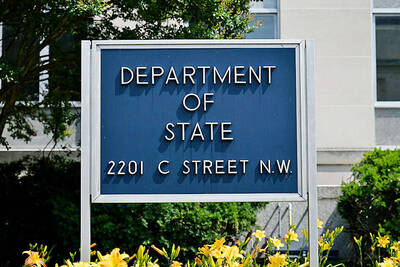An unpublicized joint military exercise between Taiwan and the US in the Pacific Ocean last month was carried out in accordance with an international code, the Ministry of National Defense (MND) said yesterday.
According to a Reuters report citing four unnamed sources, the two nations’ navies last month conducted joint drills in the Western Pacific.
The drills were not made public at the time, but “about half-a-dozen navy ships from both sides, including frigates and supply and support vessels, participated in the days-long exercises,” Reuters reported, citing the sources.

Photo: Carlos Garcia Rawlins, Reuters
The drills were designed to practice “basic” operations such as communications, refueling and resupplies, the sources said.
Ministry spokesman Major General Sun Li-fang (孫立方) said that the drills were based on the Code for Unplanned Encounters at Sea (CUES), a series of non-binding rules to prevent an escalation of tensions between militaries at sea.
Routine drills were carried out in accordance with CUES to avoid mutual interference during encounters at sea, because there are many uncertain factors during any such encounters, Sun said.
An agreement reached at the 2014 Western Pacific Naval Symposium, CUES offers safety measures and a means to limit mutual interference, to limit uncertainty and to facilitate communication when naval ships or naval aircraft encounter each other in an unplanned manner.
“It’s like I am dining in this restaurant and you also happen to be here,” Reuters quoted a source as saying. “Then it looks like I am only sharing the same table with someone.”
A third source said that although the two navies’ “unplanned encounters” involved mostly basic exercises, such drills are vital to ensure they can operate together in times of emergency.
The two navies also practiced tactical maneuvers, including searching for underwater targets, the third source said.
The Pentagon declined to comment.
The Chinese Ministry of National Defense did not immediately respond to a request for comment.
The drills, which focused on communications and other operations and did not involve live-fire maritime exercises, were not the first held to simulate encounters between Taiwanese and US naval ships, a source familiar with the matter said.
In 2016, a Taiwanese flotilla composed of the Kang Ding and Cheng Ho frigates, as well as the Panshih combat supply ship, were returning from a goodwill voyage when they unexpectedly met the USS Chaffee, a destroyer, in waters off Hawaii, the Military News Agency reported.
The Taiwanese ships established contact with the US vessel, and exchanged speed and bearing information to ensure mutual navigation safety following CUES, it said.
Separately, the MND said in a statement yesterday evening that as of 5pm, 23 Chinese warplanes had been detected operating near Taiwan, 15 of which crossed the median line of the Taiwan Strait.
Joint surveillance units kept a close watch on the situation, and aircraft, ships and shore-based missile systems were deployed to respond appropriately, it said.
Meanwhile, asked about Chinese military activity ahead of the inauguration of president-elect William Lai (賴清德) on Monday next week, Sun said that peace in the Taiwan Strait and regional stability depend on the joint efforts of all parties.
Any provocative actions would not help regional peace and stability, and Taiwan’s military is not a troublemaker and will not take provocative actions, Sun said.
The Chinese People’s Liberation Army on Saturday deployed the Lishui, a Type 052D destroyer, in waters around Penghu County.
Major General Tung Chi-hsing (董冀星), who is in charge of combat and planning affairs at the MND, said that China has also been stepping up “gray zone” warfare against Taiwan.
The MND would continue its joint intelligence, surveillance and reconnaissance operations to stay on top of developments in the Taiwan Strait and respond to any emergencies based on combat readiness guidelines and regulations, Tung said.
Additional reporting by Wu Che-yu

A car bomb killed a senior Russian general in southern Moscow yesterday morning, the latest high-profile army figure to be blown up in a blast that came just hours after Russian and Ukrainian delegates held separate talks in Miami on a plan to end the war. Kyiv has not commented on the incident, but Russian investigators said they were probing whether the blast was “linked” to “Ukrainian special forces.” The attack was similar to other assassinations of generals and pro-war figures that have either been claimed, or are widely believed to have been orchestrated, by Ukraine. Russian Lieutenant General Fanil Sarvarov, 56, head

SAFETY FIRST: Double the number of police were deployed at the Taipei Marathon, while other cities released plans to bolster public event safety Authorities across Taiwan have stepped up security measures ahead of Christmas and New Year events, following a knife and smoke bomb attack in Taipei on Friday that left four people dead and 11 injured. In a bid to prevent potential copycat incidents, police deployments have been expanded for large gatherings, transport hubs, and other crowded public spaces, according to official statements from police and city authorities. Taipei Mayor Chiang Wan-an (蔣萬安) said the city has “comprehensively raised security readiness” in crowded areas, increased police deployments with armed officers, and intensified patrols during weekends and nighttime hours. For large-scale events, security checkpoints and explosives

PUBLIC SAFETY: The premier said that security would be tightened in transport hubs, while President Lai commended the public for their bravery The government is to deploy more police, including rapid response units, in crowded public areas to ensure a swift response to any threats, President William Lai (賴清德) said yesterday after a knife attack killed three people and injured 11 in Taipei the previous day. Lai made the remarks following a briefing by the National Police Agency on the progress of the investigation, saying that the attack underscored the importance of cooperation in public security between the central and local governments. The attack unfolded in the early evening on Friday around Taipei Main Station’s M7 exit and later near the Taipei MRT’s Zhongshan

REBUFFED: In response to Chinese criticism over recent arms sales, Washington urged Beijing to engage in meaningful dialogue instead of threats and intimidation Washington’s long-term commitment to Taiwan would not change, the US Department of State said yesterday, urging Beijing to stop pressuring Taiwan and engage in meaningful bilateral dialogues. The remarks came in response to a backlash from Beijing about Washington’s latest approval of arms sales to Taiwan. The US Defense Security Cooperation Agency said in a statement on Wednesday that the Taipei Economic and Cultural Representative Office in the US has asked to purchase an arms package, including Tactical Mission Network Software; AH-1W helicopter spare and repair parts; M109A7 self-propelled howitzers; HIMARS long range precision strike systems; tube-launched, optically tracked, wire-guided missiles; Javelin